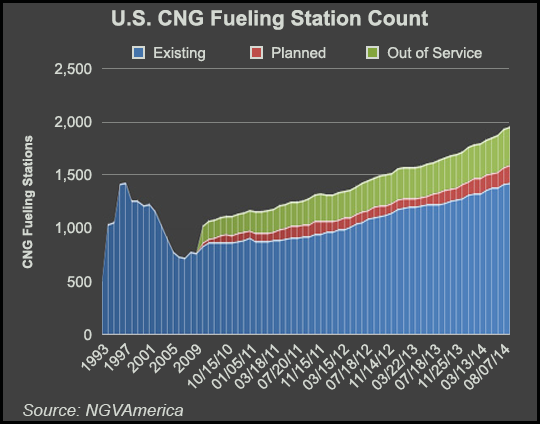Infrastructure | NGI All News Access | NGI The Weekly Gas Market Report
More Models for CNG Fueling Technology Take Shape
Natural gas vehicle (NGV) start-up GSD Systems is working on compressed natural gas (CNG) architecture for pressure vessels that would allow 20% more fuel to be stored in a back-of-the-cab structure on heavy-duty truck cabs.

With operations in Michigan and Indiana, GSD proposes to use fiber braiding to produce multi-cylinder vessels that share a single internal storage space. The fuel tank units would be shaped to fit the space available on a given vehicle, eliminating current challenges to safely installing heavy cylindrical units. Often there are no ideal places for large, round cylinders, the company said.
GSD has adapted commercial compressed air storage technology used by firefighters for CNG fuel storage use. Kevlar or other prototype heat-resistance, strong fibers, called “aramids,” are woven over an impermeable corrugated thermoplastic elastomer core, the company said.
The technology could be used for pressures greater than the 3,600 psi commonly used in most CNG cylinders in North America, and GSD is in the prototype validation stage now, according to a report in the Fleets & Fuels newsletter. Company officials claimed the potential for greater volumes of storage in the same amounts of space now used for fuel tanks.
————-
Nationally, station additions are mounting, according to NGVAmerica’s statistics showing 1,436 CNG and 101 liquefied natural gas (LNG) stations operating in the U.S., and it is projected that an additional 250 to 300 new stations will be built before the end of 2014. “The country’s station count has grown dramatically in the last three years,” the Washington, DC-based NGV trade association said.
In Tennessee, the Gibson County Utility District (GCUD) this month held a groundbreaking for a model CNG fueling complex along Interstate 40 between Memphis and Nashville. The fueling station is being developed for maximum sustainability, incorporating solar energy to power lights and accessories, with a man-made wetlands on the property used to capture storm runoff.
Constellation Energy’s Midwest Energy Solutions is building the facility, which the company said would look and perform like a $2 million station without costing as much. The Trenton, TN, station is slated for commissioning in December. Midwest Energy performed the engineering and design work, and procurement for the station equipment.
In the same area, Love’s Travel Stops plans to expand a fast-fill CNG station network to Arkansas, offering CNG in West Memphis, TN, by next spring. It would be the seventh Love’s CNG outlet on a 1,300-mile stretch of Interstate 40.
The new location would allow Swift Transportation to add to its growing CNG fleet. Overall, Swift is one of the nation’s largest commercial carriers.
Co-CEO Frank Love emphasized that professional drivers and NGV motorists could travel more than1,300 miles from Williams, AZ, to West Memphis, AR, and use natural gas. Love’s fast-fill includes fueling at 10 gallons/minute, meaning a driver can fill up with a 100 gallons equivalent tank in 10 minutes.
Newport Beach, CA-based Clean Energy Fuels Corp. said it is set to open a heavy duty NGV truck station serving LNG trucks in Carlisle, PA, for Giant/Martins, the large grocery retailer. In addition, 43 fleet operators began fueling at the network nationwide during the third quarter. Clean Energy said it also inked deals for multi-year fueling with Clean Harbors Inc., which is planning to deploy both CNG and LNG heavy duty trucks in Texas and California.
In the refuse sector, Clean Energy also has signed a deal to design, build, operate and maintain a private time-fill CNG station for Salt Lake County, UT.
Yet another new CNG station was announced in Chambersburg, PA, after Sunoco was awarded a $591,502 clean energy grant from the state for a $1.5 million facility near Interstate Highway 81. Sunoco will provide the remaining $887,000 for the project, which is expected to open in the summer. Sunoco also has received state grant money for four other CNG stations in Pennsylvania (Canonsburg, King of Prussia, Pittsburgh and New Stanton).
According to NGVAmerica, whose statistics are more robust than those of the federal Department of Energy, natural gas transportation fueling stations have been growing steadily since 2006, following a decade-long period of decline after 1997. Only about half of the growing total of stations are public access facilities.
© 2024 Natural Gas Intelligence. All rights reserved.
ISSN © 1532-1231 | ISSN © 2577-9877 | ISSN © 1532-1266 |
